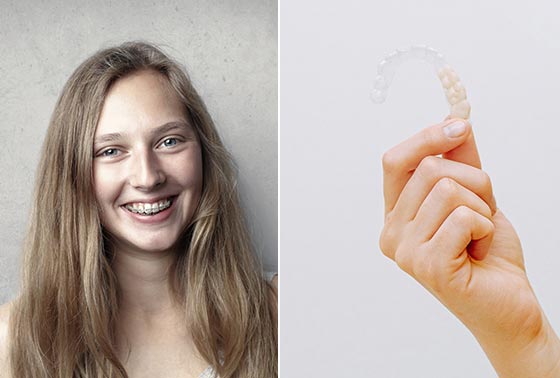The Difference Between Braces & Invisalign
Are you wondering what is the difference between braces and Invisalign?When thinking of orthodontic treatment, many used to strictly think of traditional braces. However, now there’s another popular option on the market: clear aligners, best known by the brand name Invisalign. One treatment option isn’t necessarily better than another. On the other hand, one may be recommended over another depending on a patient’s lifestyle and treatment goals.
Let’s talk a little bit about what makes each option different in terms of visibility, comfort, hygiene and diet.
Braces
Visibility: Although you can get braces in numerous models, i.e. stainless steel, tooth-colored ceramic, gold-colored and even braces that go behind the teeth, other elements like rubber bands and wires will still be visible.
Comfort: Braces may irritate mouth tissue and cause discomfort when placed or adjusted. The discomfort is brief and eventually you will forget you even have them on.
Hygiene: Frequent brushing and flossing is recommended to keep braces free of food debris and plaque so bacteria can’t damage tooth enamel.
Diet: A patient with braces should avoid hard, crunchy or sticky foods. This is because they can damage your wires and/or brackets. Also, they can decrease the effectiveness of your treatment.
Clear Aligners
Visibility: With their thin and clear trays, aligners are designed to be practically invisible.
Comfort: Aligners can cause discomfort when you switch to a new set, but it is easily managed.
Hygiene: Patient’s should continue to brush and floss as they normally would.
Diet: It’s important to stay clear of soft drinks or sports drinks when you are wearing your aligners. Drinking any of the aforementioned can lead to stains and tooth decay.
The Difference Between Braces and Invisalign – Which Is More Effective?
Both braces and aligners are effective. Both also do more than straighten teeth, they help correct bite issues too. But when looking at their effectiveness, braces are able to treat more complex dental problems. On the other hand Invisalign is great for getting teeth in their ideal position and improving their look when the tooth movements aren’t too complicated.
When Should You Use Braces? When Should You Use Invisalign?
Your orthodontist will be able to recommend the right treatment plan for you, but they will most likely look at the following factors:
- Teeth Alignment
- Bite Problems
- Lifestyle
Traditional braces are able to treat complex misalignment and bite problems more effectively. If your teeth alignment issues aren’t bad, aligners might be the right route for you.
Braces vs. Aligner Cost
When looking at the difference between braces and aligners, we know cost is bound to come up. Traditional braces can cost anywhere from $3,000 to $5,000 vs. the cost of aligners at $1,000 to $5,000. It’s important to note that not all insurance plans cover Invisalign as it is sometimes seen as a cosmetic treatment.
Conclusion
When it comes to the difference between the two, both braces and Invisalign aligners are great options for your orthodontic treatment. Your Orthodontist will be able to recommend which solution would work better for your treatment goals and lifestyle. Request a free consultation today to see which is right for you.






